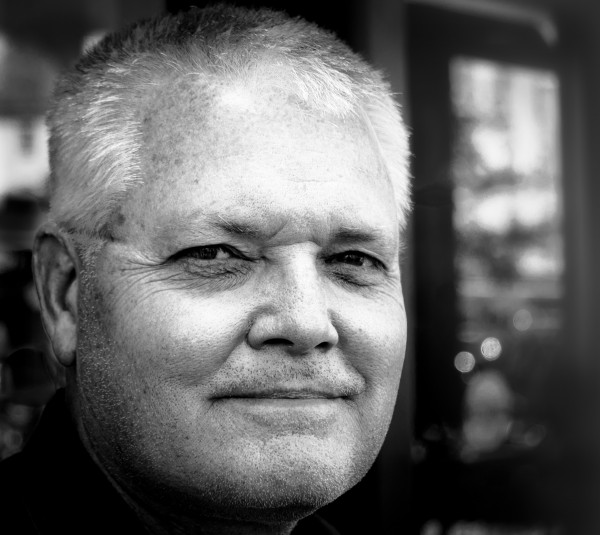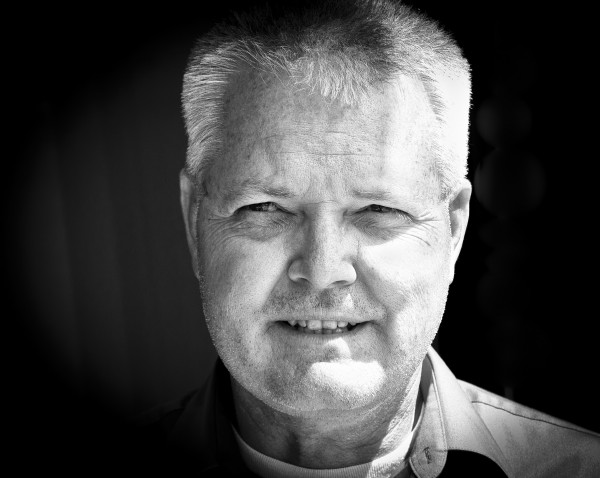The Lone Man
Something flows through the work of fine art photographer Cole Thompson. It is a current from secret, obscure shadow to revealing, engaging light. It circulates like blood flowing in ones veins, or, like warmth from the sun. Thompson often finds the edge between shadow and light, moving away to a place of solitude, examining the place without distraction, interruption or…It is so vast and yet reachable, a place where inspiration finds you. Cole Thompson has learned to work alone.
THOMPSON
The real key is to find your own style. I can’t be a great portrait photographer and great landscape photographer and a great still life photographer. So I have accepted that and now and I do what I love best, create images in my own style of fine art photography. This was a great life lesson that I learned; appreciate and focus on what you are good at and don’t be envious of what you’re not good at. To do this I had to stop caring what others thought. I’m not creating for them. I’m not doing this to earn a living. I’m doing it for me. So I divided my work into the two piles; ones that I really loved, and ones that I didn’t, and from then on I only focused on images that I had a passion for. So even if people loved those other images, or they were published, or sold well, I quit producing work that I didn’t love. This approach led me to a style and look that said: this is a Cole Thompson image. My style is very specific. It’s very dark, very contrasty, dominated by blacks.
TRIBUTARY
That takes some courage to abstain from seeking inspiration from the work of others and deciding you are going to go on alone.
THOMPSON
We’re trained to think of certain people as experts and to hang on every word they say. As well intentioned as these experts are, they are giving advice from their perspective. Their advice may be good, but it may not be good for my vision and my definition of success. I am a businessman and I see this all the time. I read a book that argued that the IBM culture of professionalism, wearing dark suits and white shirts was the best way to achieve success. But you could turn around and look at the Apple model with a casual work environment where everyone was wearing sandals and shorts. I’m not sure any one way is right but there is value in creating a plan that fits your goals, and outlook on life, and then pursuing it with conviction. Five years ago I stopped looking at other photographer’s work. The reason I did that was because I found myself constantly imitating others people’s work, style and images. I used to say that this was how I learned but really all I was doing was imitating instead of finding my own vision. So now I practice photographic celibacy. This approach may not work for you but it works for me.
TRIBUTARY
How did you make the transition from photo documentation to creating fine art?
THOMPSON
My piece called “The Angel Gabriel” is the first time I had created an image versus taking a photograph. It was the first time I molded the image that my eyes saw into the vision I had. I created something that was unique and mine. As I created this image, I learned an important lesson about following other’s advice. I love the centered image and when I showed it to my mentor she told me, never center an image, and suggested I crop it. I remember thinking how this advice didn’t feel right but since she was the expert, I went back put the image off center. It looked horrid and almost made me ill. This was not how I envisioned the image. It didn’t feel right. So, I learned not to listen to other people’s advice because it comes from their point of view and their vision, not mine.
TRIBUTARY
You have a lot of attachment to this image. Is there a story that goes with it?
THOMPSON
I met him on the Newport Beach pier. I was photographing the pier and it was a very busy day. Because I was doing a long exposure, most of the people would disappear. I could see the shot needed a subject. I looked around and saw a man eating French Fries from a trash can. He was homeless and hungry. I asked him if he would help me with a photograph and in return, I would buy him lunch. He agreed and I did a couple of shots but then he, Gabriel, wanted to hold his bible in the shot. This turned out to be the image I chose. Gabriel and I then went into a restaurant on the pier. He was dirty and carrying his bedroll and bible. He ordered steak with mushrooms and onions and told me he hadn’t had one in years. When it came, he ate it with his hands. I asked Gabriel how I might contact him, in case I sold some of the photographs and wanted to share the money with him. He said I should give the money to someone who could really use it. “I’ve got everything I need,” he said and he walked away with his bedroll and his bible.
TRIBUTARY
Where does your inspiration come from?
THOMPSON
I keep a list of about 50 ideas to pursue for projects. What I’ve found is that I’ve never been successful in turning one of those ideas into a portfolio. Every success that I’ve had has come in a moment of inspiration and I immediately pursued it. Like “Ceiling Lamps.” I’m in Akron, Ohio, standing in a hotel lobby and I looked up and saw a ceiling lamp, a simple, round lamp but standing directly beneath it, it took on this wonderful abstract shape. So I pushed away the table and couch below the lamp and just laid on the lobby floor looking at it. I thought, this is my next portfolio. A lot of people tell me that they are working on a project but it’s a struggle to get motivated. I find that if I am not excited about a project and I have to force myself to work on it, then I have the wrong project.
TRIBUTARY
Your most well-known portfolio is “The Ghosts of Auschwitz.” How did you create these images?
THOMPSON
I had no intention of photographing at the camps. I was there simply as a tourist. The first place they take you on the tour is in a room with a piles of children’s shoes, a pile of glasses, a pile of hair and other personal items taken from the victims. A few minutes into the tour I felt claustrophobic and couldn’t breathe. The presentation was so depressing that the air seemed sucked out of the room. So I went outside to find relief but couldn’t. Every time I took a step I couldn’t help but wondering, who has stepped here before me and now is dead? Who had walked in the same path and been murdered. I started thinking, I wonder if their spirits are still here? That is when the idea of photographing their spirits came to me. I had been working with long exposures for several years, mostly with water and clouds, but I had the basics down. I had 45 minutes left in the tour so I rushed to create long exposures of the other visitors at the camp. The long exposures turned the visitors into ghosts, proxies if you will, for those who had lived and died at Auschwitz-Birkenau. It was difficult to get these long exposures because the Europeans are so polite and would move out of my way when they saw me photographing. That is exactly what I didn’t want. So I had to devise ways to fool the people into thinking I wasn’t photographing. I had a cable release so I would turn my back and pull out my cell phone and act like I was on the phone so people would move back into the area. Even then it was difficult to get the images where everyone kept moving. For every photograph that worked, four didn’t. My goal was to portray Auschwitz-Birkenau differently than I had seen it portrayed in the past. I didn’t want to create historical photographs of this place, or treat it like an old museum. I wanted to show that real people lived and died here. I wanted to make people think. This is an example of how inspiration just hit me.
TRIBUTARY
So many people are interested in photography today. When they create an image that pleases them what should they do next? Frame it? Stick it in a box? Go to the closest gallery?
THOMPSON
Well how would you define success for you? The normal definition for photographers seems to be selling for big dollars, getting into a gallery or having a book published. Many automatically go down that path believing that will make them happy. So when I went down that path and had some success the resulting euphoria was fleeting and the satisfaction momentary. I realized that this definition of success was not working for me.
For me success is the freedom to create what I want and loving what I do. It is having a creative outlet that brings balance into my life. I recently posted an article on my blog where I said, “I would rather my art be in thousands of homes than sell it for thousands of dollars.” I’m glad my goal isn’t to to earn a living from my art because then I would feel pressured to produce images that others wanted and not what I was passionate about. I do enjoy exhibiting in galleries and I have a very simple requirement: the gallery loves my work and invites me. There is one galley in a small southern Colorado town that I exhibit in every year. Why? Because they love my work and invite me. Being wanted and having my art appreciated is more important to me than anything else.
TRIBUTARY
So a person doesn’t need to find an audience, just worry about yourself as the audience. Isn’t there a desire to have some kind of audience besides your family?
THOMPSON
We all like praise. We all like to have our art appreciated. There is no harm in that. But when you create for others your work lacks something. It is not as powerful or convincing as the art you create for yourself. When you create for yourself then the praises and accolades you receive are a wonderful extra. I call it the cherry on top that makes success even more sweeter.
_________________________
Alone
From childhood’s hour I have not been
As others were; I have not seen
As others saw; I could not bring
My passions from a common spring.
From the same source I have not taken
My sorrow; I could not awaken
My heart to joy at the same tone;
And all I loved, I loved alone.
Then- in my childhood, in the dawn
Of a most stormy life- was drawn
From every depth of good and ill
The mystery which binds me still:
From the torrent, or the fountain,
From the red cliff of the mountain,
From the sun that round me rolled
In its autumn tint of gold,
From the lightning in the sky
As it passed me flying by,
From the thunder and the storm,
And the cloud that took the form
(When the rest of Heaven was blue)
Of a demon in my view.
— Edgar Allen Poe, 1875
_______________________
RELATED LINKS The Lone Man – A Cole Thompson portfolio


